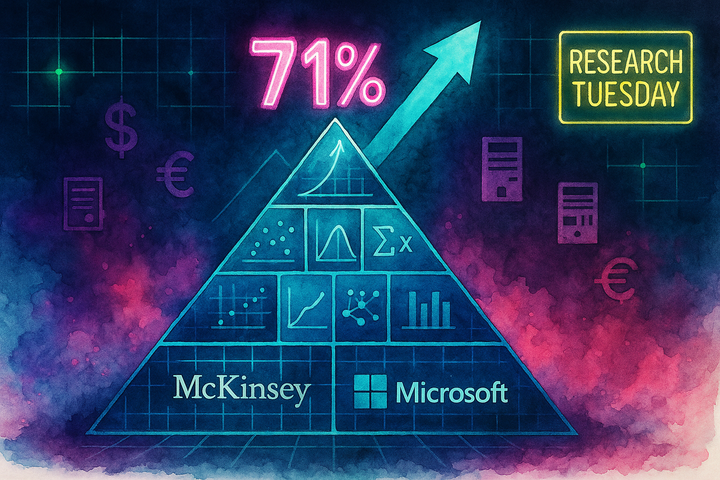Year One Multi-Agent Strategy: McKinsey's Agentic Framework Meets Microsoft's Orchestration Platform
While Oracle commits $25B in infrastructure desperation and Duolingo's CEO retreats from AI-first messaging, McKinsey's agentic framework with proven multi-agent orchestration provides the Year One roadmap that prevents expensive scaling mistakes and communication disasters.

While Oracle commits $25 billion in projected fiscal 2026 capex to chase "insatiable demand" and Duolingo's CEO walks back his "AI-first" strategy after intense public backlash, a clearer path emerges for strategic AI transformation. McKinsey's latest agentic AI research, combined with Microsoft's proven multi-agent orchestration platform, provides the roadmap Oracle's expensive scaling and Duolingo's communication failures both missed: Year One success comes from understanding agentic AI orchestration principles before infrastructure investment.
The evidence is compelling. Oracle's projected $25 billion capex for fiscal 2026—representing a massive increase from their $21.2 billion fiscal 2025 spending—exemplifies infrastructure-first thinking that creates expensive dependencies without strategic ROI. Meanwhile, Duolingo CEO Luis von Ahn's forced clarification after his April 28 "AI-first" announcement alienated users and employees validates what McKinsey's Jorge Amar emphasizes: successful AI requires "controlled, deterministic environments where clear processes exist," not messaging that prioritizes replacement over partnership.
McKinsey's Agentic Evolution: From Reactive to Autonomous Intelligence
Jorge Amar's recent framework marks a critical evolution in enterprise AI thinking. As McKinsey's global lead for digital customer care explains, "An AI agent is perceiving reality based on its training. It then decides, applies judgment, and executes something. And that execution then reinforces its learning." This progression from reactive generative AI to autonomous agentic systems addresses the core failures we see in both Oracle's infrastructure gambling and Duolingo's human-replacement messaging.
The McKinsey framework identifies five architectural principles that Oracle's clients and Duolingo's executives are missing:
Composability enables modular integration of agents, tools, and large language models without systemic reconfiguration. Oracle's client ordering "all available capacity" exemplifies the opposite approach—massive infrastructure commitments before understanding specific agent requirements. Microsoft's Azure AI Foundry demonstrates this principle through over 1,800 models in a unified catalog with intelligent routing based on task requirements.
Distributed Intelligence allows task decomposition and collaborative problem-solving across agent networks. This directly contradicts Duolingo's failed approach where von Ahn initially positioned AI as replacing human contractorsrather than collaborating with them. Wells Fargo's implementation shows the alternative: 35,000 bankers with instant access to AI agents that reduce procedural searches from 10 minutes to 30 seconds, with 75% of searches now happening through the agent while maintaining human oversight.
Layered Decoupling separates logic, memory, orchestration, and interface components to enhance flexibility. Oracle's infrastructure-heavy approach lacks this architectural sophistication, creating expensive dependencies without the modular adaptability that Microsoft's Connected Agents provide through natural language routing and specialized task delegation.
Vendor Neutrality prevents proprietary lock-in through open standards like the Model Context Protocol. This addresses Oracle's client trap of massive infrastructure dependency—once you've committed to maximum capacity, switching costs become prohibitive.
Governed Autonomy embeds policy controls and real-time monitoring for ethical, compliant operations. This is precisely what Duolingo's crisis reveals was missing. Von Ahn's initial messaging suggested AI would simply replace humans without the governance frameworks that McKinsey identifies as essential for stakeholder trust.
Multi-Agent Orchestration: From Theory to Implementation
McKinsey's strategic framework finds practical application through emerging multi-agent platforms, with Microsoft's Azure AI Foundry representing one prominent example of the orchestration-first approach. The platform's Connected Agents and Multi-Agent Workflows demonstrate the evolutionary leap from infrastructure-first thinking to orchestration-first strategy that Oracle's spending spree and Duolingo's messaging missed.
Connected Agents enable simplified workflow design that breaks down complex tasks across specialized agents to reduce complexity and improve clarity. The main agent uses natural language to route tasks, eliminating the need for hardcoded logic while providing easy extensibility and improved reliability. This pattern appears across multiple implementations: T-Mobile's PromoGenius system serves 83,000+ retail and call center endpoints with 500,000 monthly launches, while similar architectures emerge from other vendors pursuing the same orchestration principles.
Multi-Agent Workflows coordinate agents across extended processes using declarative interfaces. These stateful workflows maintain session data across extended timeframes, handle error recovery through rollback mechanisms, and escalate exceptions to human operators. T-Mobile utilizes these workflows to connect to more than 20 device manufacturers' websites, instantly assembling product information—an approach that various platforms are now implementing across the industry.
The convergence of agent frameworks merges production-grade tooling with flexible development patterns, dramatically reducing development complexity compared to manual orchestration. Organizations like KPMG are using standardized frameworks to orchestrate workflows among specialized agents, significantly simplifying multi-agent system development across various platforms.
Standardized communication protocols enable cross-agent communication through natural language APIs, knowledge sharing via vector databases, and automated performance benchmarking. This creates the interoperability foundation that Oracle's expensive infrastructure approach cannot provide alone, representing an industry-wide shift toward platform-agnostic orchestration.
Strategic Year One Framework: Agentic Before Infrastructure
The combined McKinsey-Microsoft approach reveals why Oracle's $25 billion infrastructure gamble and Duolingo's AI-first messaging both failed strategically. Year One success requires building agentic capability before requiring massive capital expenditure or workforce displacement. This accelerated Year One approach may not suit every organization—we've previously outlined more gradual multi-agent adoption timelines—but for leaders watching competitors stumble through expensive mistakes, strategic urgency often outweighs implementation caution.
30-Day Foundation: Agentic Assessment and Team Formation
The first month focuses on identifying what McKinsey calls "controlled, deterministic environments where clear processes exist." This assessment prevents both Oracle's premature infrastructure scaling and Duolingo's tone-deaf human replacement messaging.
Organizations must map existing workflows across three vectors: repetitive task automation opportunities, data-driven decision points, and customer experience friction areas. Wells Fargo's success—reducing policy searches from 10 minutes to 30 seconds while handling 75% of procedural queries through their AI agent—began with identifying specific banking procedures that benefited from AI assistance rather than replacement.
Cross-functional AI steering committees should establish what Duolingo lacked: clear governance frameworks addressing bias mitigation, transparency requirements, and workforce collaboration principles. This prevents the communication disasters that forced von Ahn's public retreat from his initial statements.
60-Day Implementation: Multi-Agent Team Design and Platform Integration
The second month emphasizes what Microsoft's platform enables: human-agent collaboration optimization for different business functions. This requires identifying processes where agents handle specific tasks while humans guide systems, resolve exceptions, and manage relationships.
Microsoft's Azure AI Foundry provides the technical foundation through its Agent Service runtime, which manages agent lifecycle states, tool invocation, and inter-agent communication. The platform's extensive connector libraryenables integration with enterprise systems while maintaining the modular architecture McKinsey's framework requires.
Human-AI collaboration patterns emerge through structured implementation across multiple platforms. T-Mobile's approach demonstrates effective orchestration: specialized agents handle specific functions (product research, comparison analysis, promotional data coordination) while human representatives maintain customer relationships and handle complex negotiations. Similar patterns emerge across various enterprise implementations.
90-Day Validation: Strategic Deployment and Continuous Learning
The third month proves strategic value before major infrastructure commitments. Modern observability frameworks provide detailed telemetry for debugging and performance optimization, while integrated compliance testing validates agent behavior against regulatory standards.
Pilot validation metrics should demonstrate both technical performance and human collaboration effectiveness. Wells Fargo's implementation across 35,000 bankers providing instant access to 1,700 internal procedures proves agents enhance rather than replace human capabilities.
This validation phase prevents Oracle's expensive scaling mistakes by proving ROI before infrastructure dependency. It also avoids Duolingo's messaging disasters by demonstrating successful human-AI collaboration rather than positioning AI as replacement technology.
Framework Integration: Preventing Infrastructure and Communication Failures
The McKinsey-Microsoft framework specifically addresses the failures we observe in both Oracle's approach and Duolingo's crisis. Strategic agentic implementation builds capability systematically rather than betting on infrastructure scale or messaging that alienates stakeholders.
Infrastructure Efficiency emerges from understanding agent requirements before scaling. Microsoft's intelligent model routing optimizes selection based on task requirements, avoiding Oracle's client trap of ordering maximum capacity without strategic planning. The platform's distributed cloud architecture integrates with edge computing for optimal performance through intelligence rather than raw infrastructure.
Communication Strategy benefits from demonstrable human-AI collaboration success. Unlike Duolingo's failed messaging that suggested human replacement, the McKinsey-Microsoft approach emphasizes augmentation. Wells Fargo's success in reducing search times while maintaining human oversight provides messaging that builds rather than erodes stakeholder trust.
Organizational Alignment develops through iterative success rather than disruptive mandates. Microsoft's integration with Teams and Office 365 enables gradual adoption that builds organizational capability without the workforce anxiety that triggered Duolingo's crisis.
Competitive Advantage Through Strategic Implementation
Organizations implementing the McKinsey-Microsoft framework report measurable advantages over infrastructure-first and AI-first approaches:
71% of Frontier Firm workers using strategic human-agent teams report their companies are thriving, compared to just 37% globally. This validates McKinsey's emphasis on controlled implementation over hasty scaling.
Proven productivity improvements emerge from multi-agent orchestration, as demonstrated by T-Mobile's 500,000+ monthly PromoGenius launches serving 83,000+ endpoints and Wells Fargo's procedural efficiency gains across 4,000 branches.
Strategic deployment capabilities accelerate through Microsoft's unified development framework, enabling organizations like HCLTech to resolve cases 40% faster while redeploying 30% of their 500-person support staff to higher-value work.
July 8 Global Presentation: Complete Implementation Roadmap
The evidence is clear: while competitors make Oracle-style infrastructure mistakes and suffer Duolingo-style messaging disasters, strategic leaders can implement McKinsey's agentic framework using Microsoft's proven platform capabilities. The Year One approach prevents expensive dependencies and public relations crises while building sustainable competitive advantage.
Join me for the complete roadmap on July 8 during my global AgileRTP presentation. We'll walk through the detailed framework with week-by-week milestones that prevent infrastructure dependency and messaging disasters while building the human-agent teams that define competitive advantage.
This isn't theory—it's the practical synthesis of McKinsey's latest research with Microsoft's production-proven platform, validated by enterprise success cases that demonstrate measurable ROI without the expensive mistakes or communication failures we see elsewhere.
Register for the July 8 global presentation: Human/AI Hybrid Workforce: Year One. While others stumble through infrastructure gambling and messaging disasters, we'll build the strategic foundation for sustainable AI transformation.




Comments ()